-
In October 2021 I came across this intriguing chair being sold by online auction, estimate £5 - £15, description "rush seated chair". At the time, I couldn't quite believe my eyes and subsequently giddily bid online and won the chair for £45.
If my instinct is correct, this is an extremely rare survival of a skeined willow woven seated chair. I'm beginning now to research the origins of this highly unusual looking chair, which for me feels of the Regency period, as if it's been plucked out of the Brighton Pavilion, but it maybe of later Victorian origin.
-
Of course I'm hoping that this chair seat is made of skeined willow as apposed to cane, (though cane would still be impressive!)
What my instinct is telling me is that the beautiful mellow golden colour, the deep sheen plus the marks on the material where the buds would have been, all make me think of willow. Skeined willow is made by cleaving, (splitting), whole willow rods into three or four pieces, and shaving the split pieces to obtain even-sized, ribbon-like strips or ‘skeins’. In comparision, to me cane material feels dull, a pallid colour whose strips show horizontal bars and slight ridges along their length.
-
On the underside of the chair, skeined willow chairs do however have a cane foundation, in effect a mesh grid once called a 'Johnny save all'! Willow seats reputedly gave way all at once, so this cane foundation supposedly prevented someone falling right through! Looking closely at the underside of my chair, the foundation material does look different from the damask top weave. Along the chair rails, spaced about 1" apart, are a series of drilled holes, another clue indicating that this is a skeined willow chair.
-
The detail of the damask weave is incredible. There are examples of a similar chair seat pattern made by Leslie Maltby for the English Museum of Rural Life in Reading catalogued along with an interesting article by the Antique Collector 7/83 titled 'Repairing Victorian Willow Chair Seats'.
-
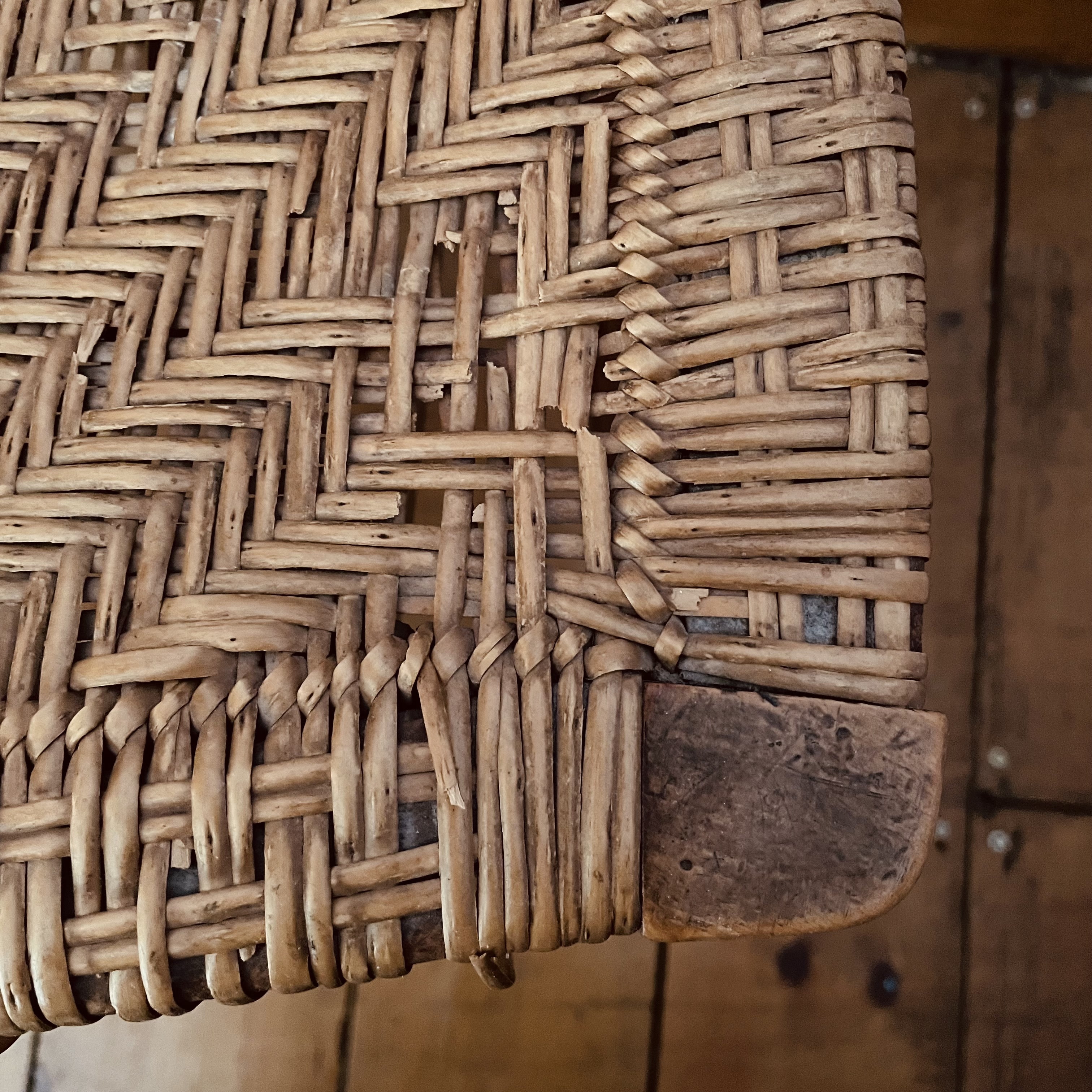
Such delicate looking chairs were known as 'occasional' chairs and it is thought so few now survive due to the short 15 - 20 year life span of the skeined willow seat. What I find particularly interesting is that according to the article, skeined willow seating was only ever done by basketmakers, not by chair seaters who worked in cane or rush.
If you know of any further examples of skeined willow chairs or have come across this design of chair before then please do let me know. Meanwhile, I'm treasuring this beautiful, fragile chair and wondering how to preserve and prevent further damage to the seat. What a find!
_____
Update January '22. Mary Butcher, who is one of the most prominent researchers into skeined willow chairs has been in contact with me and believes my chair to be an example of a skeined willow chair from the Eygptian Aesthetic movement. The chair is most likely to have been made in 1870 - 1880’s in High Wycombe. Mary has an ebonised and gold gilt unseated chair in the Eygptian style that looks to have the same frame proportions and identical form for the legs. As soon as I saw the words "Eygptian" the quirky chair back design made complete sense! I'm now going to carry out further research by heading to the High Wycombe chair museum. I'm just so pleased that my gut instinct was right and that this is a skeined willow chair of incredible rarity that i will now be able to study and if I'm incredibly lucky I maybe able to discover the chair maker.
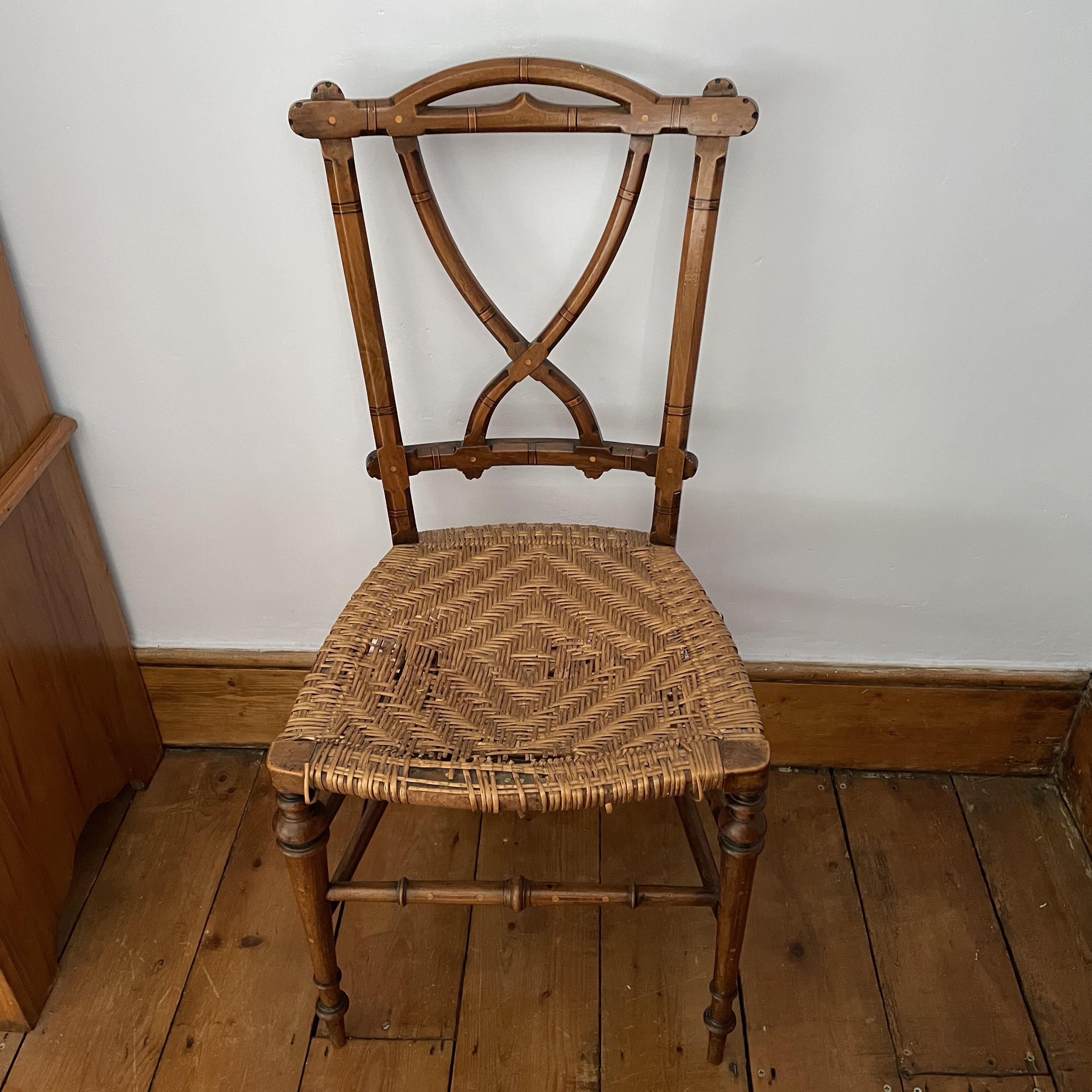 In October 2021 I came across this intriguing chair being sold by online auction, estimate £5 - £15, description "rush seated chair". At the time, I couldn't quite believe my eyes and subsequently giddily bid online and won the chair for £45. If my instinct is correct, this is an extremely rare survival of a skeined willow woven seated chair. I'm beginning now to research the origins of this highly unusual looking chair, which for me feels of the Regency period, as if it's been plucked out of the Brighton Pavilion, but it maybe of later Victorian origin.
In October 2021 I came across this intriguing chair being sold by online auction, estimate £5 - £15, description "rush seated chair". At the time, I couldn't quite believe my eyes and subsequently giddily bid online and won the chair for £45. If my instinct is correct, this is an extremely rare survival of a skeined willow woven seated chair. I'm beginning now to research the origins of this highly unusual looking chair, which for me feels of the Regency period, as if it's been plucked out of the Brighton Pavilion, but it maybe of later Victorian origin.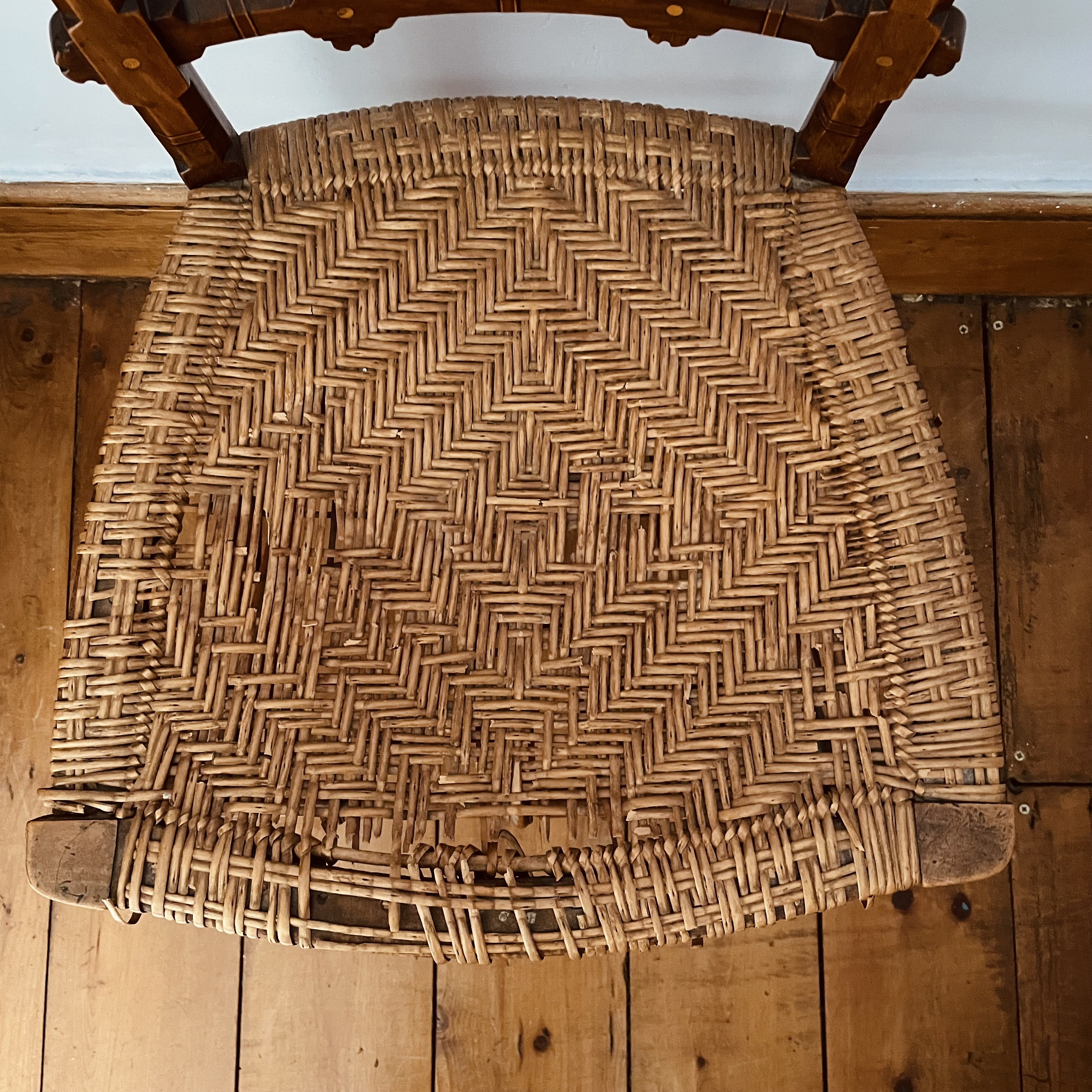 Of course I'm hoping that this chair seat is made of skeined willow as apposed to cane, (though cane would still be impressive!) What my instinct is telling me is that the beautiful mellow golden colour, the deep sheen plus the marks on the material where the buds would have been, all make me think of willow. Skeined willow is made by cleaving, (splitting), whole willow rods into three or four pieces, and shaving the split pieces to obtain even-sized, ribbon-like strips or ‘skeins’. In comparision, to me cane material feels dull, a pallid colour whose strips show horizontal bars and slight ridges along their length.
Of course I'm hoping that this chair seat is made of skeined willow as apposed to cane, (though cane would still be impressive!) What my instinct is telling me is that the beautiful mellow golden colour, the deep sheen plus the marks on the material where the buds would have been, all make me think of willow. Skeined willow is made by cleaving, (splitting), whole willow rods into three or four pieces, and shaving the split pieces to obtain even-sized, ribbon-like strips or ‘skeins’. In comparision, to me cane material feels dull, a pallid colour whose strips show horizontal bars and slight ridges along their length.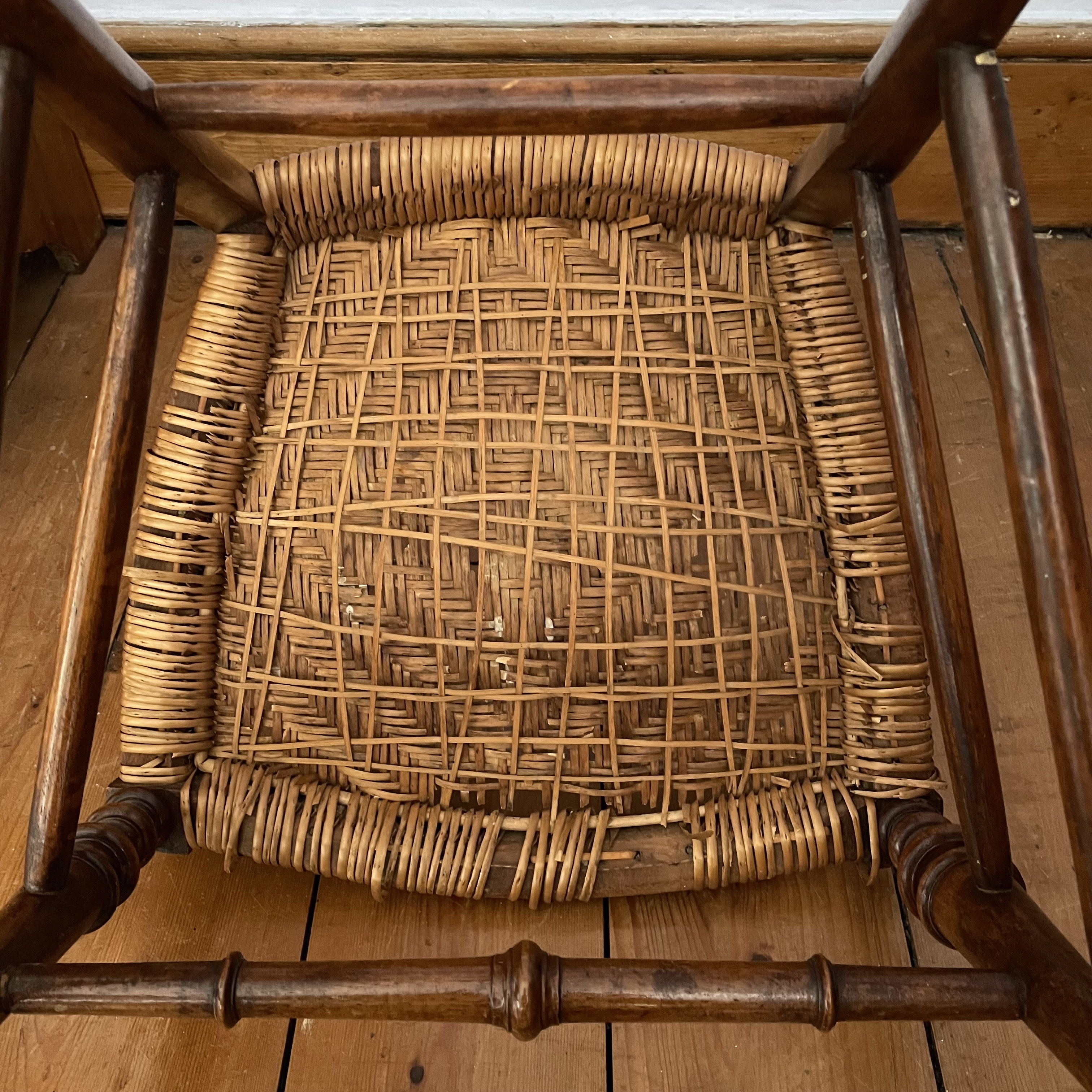 On the underside of the chair, skeined willow chairs do however have a cane foundation, in effect a mesh grid once called a 'Johnny save all'! Willow seats reputedly gave way all at once, so this cane foundation supposedly prevented someone falling right through! Looking closely at the underside of my chair, the foundation material does look different from the damask top weave. Along the chair rails, spaced about 1" apart, are a series of drilled holes, another clue indicating that this is a skeined willow chair.
On the underside of the chair, skeined willow chairs do however have a cane foundation, in effect a mesh grid once called a 'Johnny save all'! Willow seats reputedly gave way all at once, so this cane foundation supposedly prevented someone falling right through! Looking closely at the underside of my chair, the foundation material does look different from the damask top weave. Along the chair rails, spaced about 1" apart, are a series of drilled holes, another clue indicating that this is a skeined willow chair.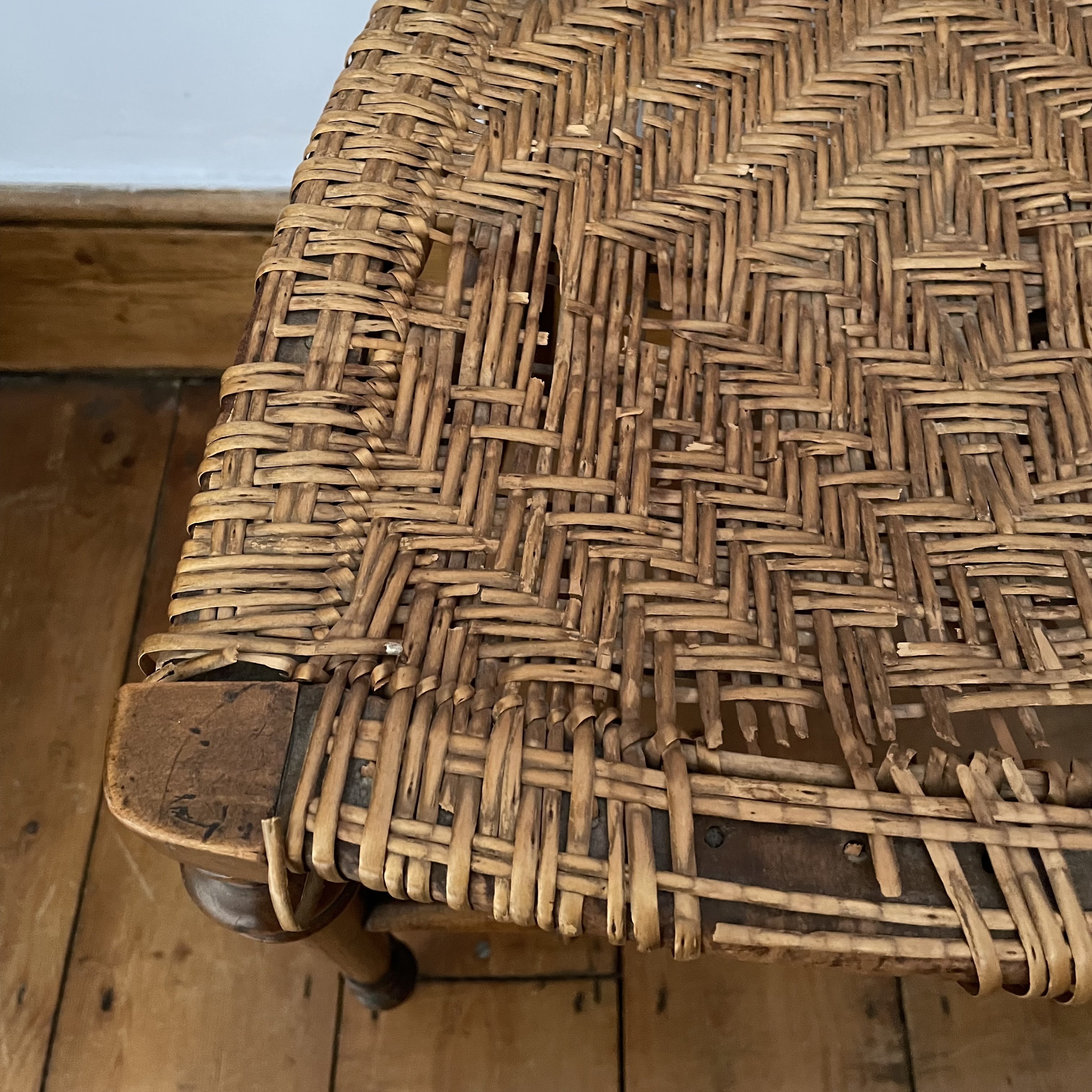 The detail of the damask weave is incredible. There are examples of a similar chair seat pattern made by Leslie Maltby for the English Museum of Rural Life in Reading catalogued along with an interesting article by the Antique Collector 7/83 titled 'Repairing Victorian Willow Chair Seats'.
The detail of the damask weave is incredible. There are examples of a similar chair seat pattern made by Leslie Maltby for the English Museum of Rural Life in Reading catalogued along with an interesting article by the Antique Collector 7/83 titled 'Repairing Victorian Willow Chair Seats'. Such delicate looking chairs were known as 'occasional' chairs and it is thought so few now survive due to the short 15 - 20 year life span of the skeined willow seat. What I find particularly interesting is that according to the article, skeined willow seating was only ever done by basketmakers, not by chair seaters who worked in cane or rush. If you know of any further examples of skeined willow chairs or have come across this design of chair before then please do let me know. Meanwhile, I'm treasuring this beautiful, fragile chair and wondering how to preserve and prevent further damage to the seat. What a find! _____ Update January '22. Mary Butcher, who is one of the most prominent researchers into skeined willow chairs has been in contact with me and believes my chair to be an example of a skeined willow chair from the Eygptian Aesthetic movement. The chair is most likely to have been made in 1870 - 1880’s in High Wycombe. Mary has an ebonised and gold gilt unseated chair in the Eygptian style that looks to have the same frame proportions and identical form for the legs. As soon as I saw the words "Eygptian" the quirky chair back design made complete sense! I'm now going to carry out further research by heading to the High Wycombe chair museum. I'm just so pleased that my gut instinct was right and that this is a skeined willow chair of incredible rarity that i will now be able to study and if I'm incredibly lucky I maybe able to discover the chair maker.
Such delicate looking chairs were known as 'occasional' chairs and it is thought so few now survive due to the short 15 - 20 year life span of the skeined willow seat. What I find particularly interesting is that according to the article, skeined willow seating was only ever done by basketmakers, not by chair seaters who worked in cane or rush. If you know of any further examples of skeined willow chairs or have come across this design of chair before then please do let me know. Meanwhile, I'm treasuring this beautiful, fragile chair and wondering how to preserve and prevent further damage to the seat. What a find! _____ Update January '22. Mary Butcher, who is one of the most prominent researchers into skeined willow chairs has been in contact with me and believes my chair to be an example of a skeined willow chair from the Eygptian Aesthetic movement. The chair is most likely to have been made in 1870 - 1880’s in High Wycombe. Mary has an ebonised and gold gilt unseated chair in the Eygptian style that looks to have the same frame proportions and identical form for the legs. As soon as I saw the words "Eygptian" the quirky chair back design made complete sense! I'm now going to carry out further research by heading to the High Wycombe chair museum. I'm just so pleased that my gut instinct was right and that this is a skeined willow chair of incredible rarity that i will now be able to study and if I'm incredibly lucky I maybe able to discover the chair maker.